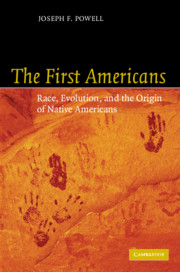Book contents
- Frontmatter
- Contents
- Acknowledgments
- Prologue: The Kennewick controversy
- PART I Race and variation
- 1 Debating the origins of Native Americans
- 2 A brief history of race
- 3 Evolutionary approaches to human variation
- 4 Recent population variation in the Americas
- PART II The Pleistocene peopling of the Americas
- PART III The First Americans, race and evolution
- References
- Index
3 - Evolutionary approaches to human variation
Published online by Cambridge University Press: 21 August 2009
- Frontmatter
- Contents
- Acknowledgments
- Prologue: The Kennewick controversy
- PART I Race and variation
- 1 Debating the origins of Native Americans
- 2 A brief history of race
- 3 Evolutionary approaches to human variation
- 4 Recent population variation in the Americas
- PART II The Pleistocene peopling of the Americas
- PART III The First Americans, race and evolution
- References
- Index
Summary
We disagree with the notion that this individual [Kennewick Man] is Caucasian. Scientists say that because the individual's head measurements do not match ours, he is not Native American. We believe humans and animals change over time to adapt to their environment. And our elders have told us that Indian people did not always look the way we look today.
Armand Minthorn, 1996 (Umatilla tribal spokesman)INTRODUCTION TO EVOLUTIONARY GENETICS
Racial–typological approaches, discussed in Chapter 2, are attempts to interpret human biological variation without making explicit reference to models of population structure and evolution. The alternative to the racial–typological view of human variation is an evolutionary approach. In this chapter, I discuss the forces of evolution and the underlying mathematical models for mutation, selection, migration, and random genetic drift. Human skeletal and dental diversity has an underlying genetic basis. The genes underlying such diversity can be used to create evolutionary models that can tell us about the origin, demographic history, and microevolution of Native Americans over the past 12,000 or so years. Racial typology and categorization cannot provide this information without numerous simplifying assumptions.
These include the primary assumption that each human population is totally distinctive in morphology and changes only as a result of historical events, such as when a racially different group invades/colonizes and replaces the original population.
- Type
- Chapter
- Information
- The First AmericansRace, Evolution and the Origin of Native Americans, pp. 58 - 84Publisher: Cambridge University PressPrint publication year: 2005



